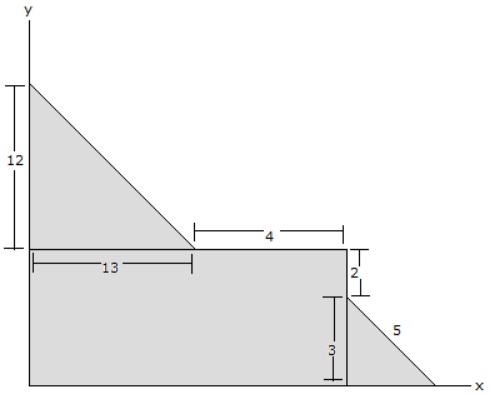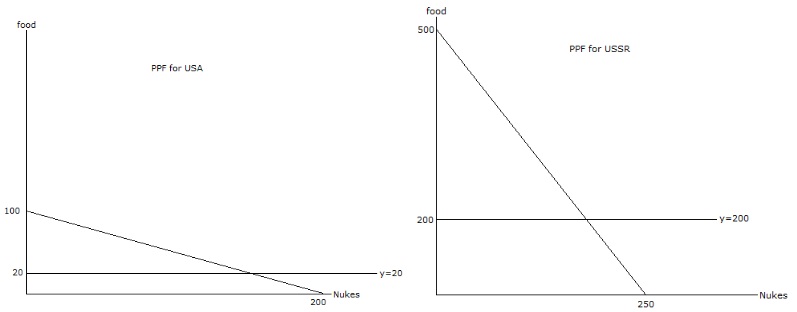Problem 1.) You’ve got two lines: y=2x+1 and y=2 – x
a.) What is the slope of each line?
b.) What is the y - intercept of each line?
c.) What is the x - intercept of each line?
d.) Where do these lines intersect? (Note that you’ll need to be able to do this both graphically and algebraically, but pick your favorite method here.)
e.) Graph these lines neatly.
f.) What would be the equation for a line that is identical to y=2x+1 except that this new lin e is shifted to the left by five units at every point?
Problem 2.) Yi (pronounced “ee”) has got this thing that’s a weird shape and she wants to know its area. Find it! On the y - axis, the units are dollars per cabbage , and on the x - axis the units are number of c abbages. What units should the answer be in? Note that it’s not even a little bit drawn to scale . Hint: If you have trouble with the bottom, right triangle, Google the Pythagorean Theorem!

The Production Possibilities Frontier:
Problem 3.) This is a story ab out two peaceful countries. Each one has a population that produces food and makes intercontinental thermonuclear ballistic missiles. They can do these activities in any amount they choose, but each country should be sure that its people get enough to eat (otherwise there is a revolution and the people overthrow the government). The trade - off between food and intercontinental thermonuclear ballistic missiles may be illustrated as follows (for convenience, say y=food and x=nuclear weapons):
USA has a PPF de fined by y=100 – 1/2x and needs at least y=20 to feed its population
USSR has a PPF defined by y=500 – 2x and needs at least y=200 to feed its population

a.) What is the opportunity cost of the USA making one more nuke?
b.) What is the opportunity cost of t he USSR making one more nuke?
c.) If these countries are friends and decide to trade, which country will produce only food and which will produce only nukes? Hint: compare opportunity costs to look for a comparative advantage. Uh oh! It looks like war! These two countries have stopped trading, so now each is forced to produce food and nukes independently. This is a cold war, so the country with the most nuclear weapons automatically wins.
d.) Who is going to win the war, and, more importantly, why? State your answer briefly and justify it with a little algebra.
Opportunity Cost:
Problem 4.) Jing (pronounced “jing”) has decided to purchase her textbooks for the semester. Her options are to purchase the books via the Internet with next day delivery to her home at a cost of $175, or to drive to campus tomorrow to buy the books at the university bookstore at a cost of $170. Last week she drove to campus to buy a concert ticket because they offered 25 percent off the regular price of $16. If Jing is rational what w ill she do? Explain briefly.
Comparative Advantage and Trade
Problem 5.) Suppose Zichen (pronounced “zuh - chin”) and Zhewen (pronounced “jo - win”) are doing Math and Econ homework. Regardless of the difficulty of the problems, it takes 10 minutes for Zichen and 15 minutes for Zhewen to solve one Math question. While solving an Econ question takes Zichen 6 minutes but Zhewen 20 minutes.
a.) In one hour, how many Math questions can Zichen solve? How about Zhewen?
b.) In one hour, how many Econ questions can Zichen solve? How about Zhewen ?
c.) Who has the absolute advantage in solving Math questions?
d.) Who has the absolute advantage in solving Econ questions? e.) What is the opportunity cost of solving a Math question for Zichen ? What about for Zhewen ?
f.) What is the opportunity cost of solving an Econ question for Zichen? What about for Zhewen?
g.) Who has the comparative advantage in solving Math questions?
h.) Who has the comparative advantage in solving Econ questions?
i.) Suppose they work together. Who will specialize in Math questions and who will specialize in Econ questions? (TA’s note to students : don’t try this at home; it’s academically unethical!)
j.) If they were to trade with each other, what is the price range (in terms of number of Math problems) a cceptable to both Zichen and Zhewen for an Econ question?
Problem 6.) Consider Robinson Crusoe , the famous novel by Daniel Defoe (we adapt it a little for our purpose). Suppose Friday stayed on the island of Despair when Robinson was rescued. As the only person on the island, Friday produces only two kinds of food: coconuts and fish. In one week, Friday can produce 100 coconuts and 0 fish, or 0 coconuts and 50 fish, or any other combination lying on the line between these two points. Meanwhile, Robinson comes and visits Friday every week during his journey of selling coconuts and fish all over the world. Suppose Robinson is willing to pay $2 per coconut and $1 per fish when he buys coconuts or fish.
a .) What is the opportunity cost of producing a coconut for Frida y?
b.) Robinson is interested in getting coconuts from Friday. What is the maximum number of fish Robinson is willing to pay for one coconut?
c.) Is Friday willing to trade with Robinson according to the above prices ($2 per coconut and $1 per fish )? (Hint: you might find it handy to consider the ratio $2 per coconut/$1 per fish and then simplify the units of measurement in this ratio to see Robinson’s opportunity cost of producing 1 coconut.)
d.) If Friday wants to trade with Robinson, what will Friday sell and what will he buy? If Friday does not want to trade, explain why?